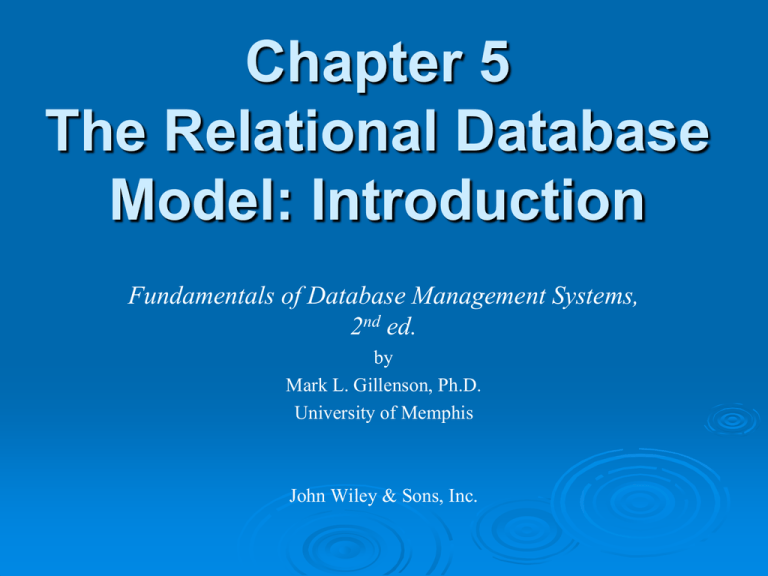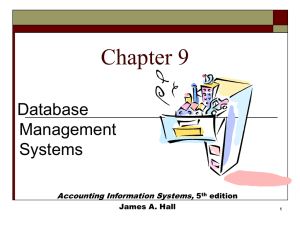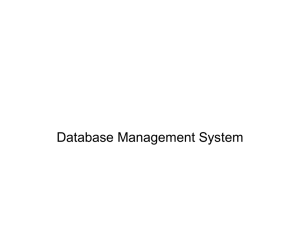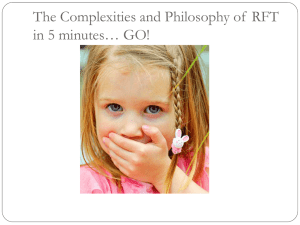
Chapter 5
The Relational Database
Model: Introduction
Fundamentals of Database Management Systems,
2nd ed.
by
Mark L. Gillenson, Ph.D.
University of Memphis
John Wiley & Sons, Inc.
Chapter Objectives
Explain why the relational database model
became practical in about 1980.
Define such basic relational database
terms as relation and tuple.
Describe the major types of keys including
primary, candidate, and foreign.
5-2
Chapter Objectives
Describe how one-to-one, one-to-many, and
many-to-many binary relationships are
implemented in a relational database.
Describe how relational data retrieval is
accomplished in concept with the select, project,
and join operators.
Understand how the join operator facilitates data
integration in relational database.
5-3
Relational Database Model
In 1970, E. F. Codd published “A
Relational Model of Data for Large Shared
Data Banks” in CACM.
In the early 1980s, commercially viable
relational database management systems
became available.
5-4
Relational Database Model
While relational database was very tempting in
concept in the 1970s, it was not easily applicable
in a real-world environment for reasons related
to performance.
The earlier hierarchical and network database
management systems were just coming onto the
commercial scene and were the focus of intense
marketing efforts by the software and hardware
vendors.
5-5
The Relational Database
Concept
Data appears to be stored in what we have been
referring to as simple, linear files.
Relational databases are based on
mathematics.
A relational database is a collection of relations
that, as a group, contain the data that describes
a particular business environment.
5-6
Relational Terminology
Relations - what we have been referring to
as simple linear files. Also called tables.
Row = record (files) = tuple (relation)
Column = field (files) = attribute (relation)
5-7
Relational Database
Terminology
5-8
File / Relation: Differences
The columns of a relation can be arranged
in any order without affecting the meaning
of the data. This is not true of a file.
The rows of a relation can be arranged in
any order, which is not true of a file.
5-9
File / Relation: Differences
Every row/column position (a cell) can
have only a single value, which is not
necessarily true in a file.
No two rows of a relation are identical,
which is not necessarily true in a file.
5-10
Primary Key
A relation always has a unique primary
key.
A primary key (also called “the key”) is an
attribute or a group of attributes whose
values are unique throughout all of the
rows of the relation.
5-11
Primary Key
5-12
Primary Key
The number of attributes involved in the
primary key is always the minimum
number of attributes that provide the
uniqueness quality.
In the worst case, all of the relation’s
attributes combined could serve as the
primary key.
5-13
Candidate Key
If a relation has more than one attribute or
minimum group of attributes that
represents a way of uniquely identifying
the entities, then they are each called a
candidate key.
When there is more than one candidate
key, one of them must be chosen to be the
primary key of the relation.
5-14
Candidate Key
Which candidate key
to pick depends on
the application using
the database.
Alternate key is a
candidate key that
was not chosen to be
the primary key of the
relation.
5-15
Foreign Key
An attribute or group of attributes that serves as the
primary key of one relation and also appears in another
relation (foreign key in this relation).
5-16
Foreign Key
Crucial in relational database, because the
foreign key is the mechanism that ties
relations together to represent unary,
binary, and ternary relationships.
Foreign key attribute must have same
domain of values as Primary key attribute
in other relation.
5-17
Domain of Values
Two attributes have the same domain of
values if the attributes have values of the
same type.
e.g.,
Salesperson Number in SALESPERSON
and in CUSTOMER - three digit whole
numbers that are the identifiers for
salespersons.
5-18
Binary Relationships
One-to-One
One-to-Many
Many-to-Many
5-19
One-to-Many Binary
Relationship
Salesperson
Customer
The Salesperson Number
foreign key in the
CUSTOMER relation
effectively establishes the
one-to-many relationship
between salespersons
and customers.
5-20
Foreign Key Can Be A Part of
The Primary Key
Customer
Customer
Employee
5-21
General Hardware Co.
5-22
Many-to-Many Binary
Relationship
Salesperson
Product
5-23
Many-to-Many Relationship
5-24
Intersection Data
5-25
Many-to-Many Relationship
Has its own relation in the database.
Can have its own attributes.
It is a kind of entity -- an Associative Entity
5-26
SALES Relation (modified)
A Date attribute is
required if the data
may be stored two or
more times in a year.
A Time attribute is
required if the data
may be stored more
than once in a day.
5-27
Unacceptable: Many-to-Many
5-28
SALES Relation (without
intersection data)
5-29
One-to-One Binary
Relationship
5-30
General Hardware Co.
including OFFICE
5-31
General Hardware Co.
including OFFICE
Can SALESPERSON
and OFFICE be
combined into one
relation?
5-32
Data Retrieval from a
Relational Database
The discussion thus far has concentrated
on:
how
a relational database is structured
loading a database with data
Let’s discuss the effort to retrieve the data
in a way that is helpful and beneficial to
the business organization that built the
database.
5-33
Relational DBMS
Have the ability to accept high level data
retrieval commands
Process the commands against the
database’s relations
and return the desired data.
5-34
The Relational Select
Operator
Retrieves a horizontal slice of the relation.
Select rows from the SALESPERSON
relation in which Salesperson Number =
204.
The result of a relational operation will
always be a relation.
5-35
The Relational Project
Operator
Retrieves a vertical slice of the relation.
Project the Salesperson Number and
Salesperson Name over the
SALESPERSON relation.
5-36
Extracting Data Across
Multiple Relations: Data
Integration
A DBMS must be able to store data
nonredundantly while also providing a data
integration facility.
Relational DBMSs automate the cross-relation
data extraction process in such a way that it
appears that the data in the relations is
integrated while also remaining nonredundant.
5-37
Data Integration
The relational algebra Join command.
Join the SALESPERSON relation and the
CUSTOMER relation, using the Salesperson
Number of each as the join fields.
Select rows from that result in which Customer
Number = 1525.
Project the Salesperson Name over that last
result.
5-38
Terminology
Cartesian Product - comparing every
possible combination of two sets, or two
relations.
Equijoin - a join where two join field values
are identical.
Natural join - one of the two identical join
columns is eliminated.
5-39
Good Reading Bookstores
5-40
World Music Association
5-41
Lucky Rent-A-Car
5-42
“Copyright 2004 John Wiley & Sons, Inc. All rights reserved. Reproduction
or translation of this work beyond that permitted in Section 117 of the 1976
United States Copyright Act without express permission of the copyright owner
is unlawful. Request for further information should be addressed to the
Permissions Department, John Wiley & Sons, Inc. The purchaser may make
back-up copies for his/her own use only and not for distribution or resale. The
Publisher assumes no responsibility for errors, omissions, or damages caused
by the use of these programs or from the use of the information contained
herein.”
5-43









